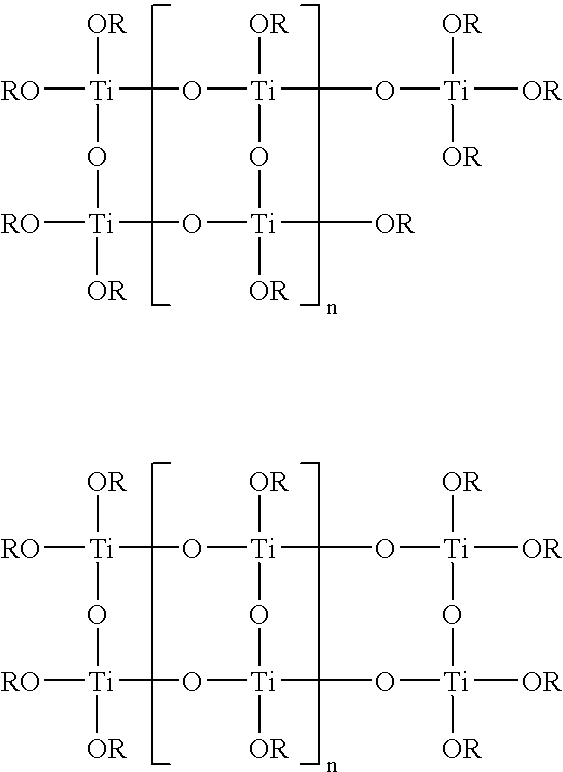Method for making a titanium-containing lubricant additive
- Summary
- Abstract
- Description
- Claims
- Application Information
AI Technical Summary
Benefits of technology
Problems solved by technology
Method used
Image
Examples
example 1
Product Made With Dispersant
[0060]A 1-liter 4-neck flask equipped with a distillation condenser, and nitrogen atmosphere was charged with 538.5 g of polyisobutenyl succinimide dispersant (2100 Mn, about 45 wt. % oil, TBN=23) and 139.3 g of process oil. The mixture was heated to about 90° C. and then 56.8 g (0.2 moles) of titanium isopropoxide was added dropwise over 10-15 minutes. To this mixture, a pre-mixed solution of 36 g (0.6 moles) of isopropanol and 7.2 g (0.4 moles) of water was added dropwise over approx. 25-35 min. After the addition was complete, the mixture was stirred at 90° C. for 3 hrs. The temperature was then increased to 120° C., held for about 45 min. and then vacuum stripped. The product thus obtained was homogenous and contained about 1.43 wt. % Titanium.
example 2
Product Made Without Dispersant
[0061]A 1-liter 4-neck flask equipped with a distillation condenser, and nitrogen atmosphere was charged with 678 g of process oil. The mixture was heated to about 90° C. and then 28.4 g (0.1 moles) of titanium isopropoxide was added dropwise over 10-15 min. To this mixture, a pre-mixed solution of 18 g (0.3 moles) of isopropanol and 3.6 g (0.2 moles) of water was added dropwise over approx. 25-35 min. After the addition was complete, the mixture was stirred at 90° C. for 3 hrs. The temperature was then increased to 120° C., held for about 45 min. and then vacuum stripped. The product thus obtained gave a precipitate, believed to be of titanium oxide, was filtered and thoroughly washed with hexane. As shown by comparing this Example 2 with Example 1, a homogenous product substantially devoid of precipitates is made when a dispersant is used in the reaction of titanium isopropoxide and water.
example 3
[0062]In the following example, wear scar results were obtained using a high frequency reciprocating rig (HFRR). The results include the product made according to example 1 using 150 solvent neutral process oil and the dispersant with various amounts the titanium additive product. The samples did not contain ZDDP.
TABLE 2DispersantTitanium Additive ProductWear ScarSample No.(wt. %)(ppm Ti)(μm2)10.8072520.810061531.3085541.530066052.5074362.4300551
[0063]The foregoing table provides a comparison of wear scar for three levels of dispersant and two levels of titanium additive product. As shown by the foregoing results, samples containing the titanium additive product exhibited lower wear scar results on the (HFRR) testing rig with the lowest results being obtained by sample 6 containing 300 ppm of the titanium product and 2.4 wt. % of the dispersant.
[0064]In order to demonstrate an improvement in the rate of lubricating film formation as well as the area of lubricating film formed as det...
PUM
| Property | Measurement | Unit |
|---|---|---|
| Temperature | aaaaa | aaaaa |
| Fraction | aaaaa | aaaaa |
| Percent by mass | aaaaa | aaaaa |
Abstract
Description
Claims
Application Information
 Login to View More
Login to View More - R&D
- Intellectual Property
- Life Sciences
- Materials
- Tech Scout
- Unparalleled Data Quality
- Higher Quality Content
- 60% Fewer Hallucinations
Browse by: Latest US Patents, China's latest patents, Technical Efficacy Thesaurus, Application Domain, Technology Topic, Popular Technical Reports.
© 2025 PatSnap. All rights reserved.Legal|Privacy policy|Modern Slavery Act Transparency Statement|Sitemap|About US| Contact US: help@patsnap.com



